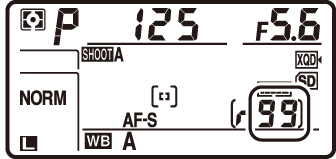Choosing a Release Mode
To choose a release mode, press the release mode dial lock release and turn the release mode dial so that the pointer aligns with the desired setting.

Pointer
Power Source and Frame Rate
The maximum frame advance rate varies with the power source. The figures below are the average maximum frame rates available with continuous-servo AF, manual or shutter-priority auto exposure, a shutter speed of 1/250 s or faster, settings other than Custom Setting d1 at default values, and memory remaining in the memory buffer.
| Power source | Maximum frame rate (fps) | |
|---|---|---|
| Ch | Cl | |
| Camera with EN-EL15a battery or with EP-5B power connector and EH-5c/EH-5b AC adapter | 7 | 1–6 |
| Camera with MB-D18 (EN-EL15a or AA) | 7 | 1–6 |
| Camera with MB-D18 (EN-EL18c) | 9 | 1–8 |
The stated rates may not be available under some conditions. Frame rate drops with some lenses, at slow shutter speeds, very small apertures (high f-numbers), or high ISO sensitivities (Hi 0.3 to Hi 2), or when ISO sensitivity is altered via auto ISO sensitivity control (0 Auto ISO Sensitivity Control), flicker is detected with Enable selected for Flicker reduction > Flicker reduction setting in the photo shooting menu (0 Flicker Reduction), vibration reduction (available with VR lenses) is on, the battery is low, the AA batteries inserted in the MB-D18 battery pack are low or cold, or a non-CPU lens is attached with Aperture ring selected for Custom Setting f4 (Customize command dials) > Aperture setting (0 Customize Command Dials).
The Memory Buffer
The camera is equipped with a memory buffer for temporary storage, allowing shooting to continue while photographs are being saved to the memory card. Note, however, that frame rate will drop when the buffer is full (tAA).
The approximate number of images that can be stored in the memory buffer at current settings is shown in the exposure-count displays in the viewfinder and control panel while the shutter-release button is pressed halfway, and can be viewed in the monitor during live view. The number may drop briefly immediately after the camera is turned on.


While photographs are being recorded to the memory card, the memory card access lamp will light. Depending on shooting conditions and memory card performance, recording may take from a few seconds to a few minutes. Do not remove the memory card or remove or disconnect the power source until the access lamp has gone out. If the camera is switched off while data remain in the buffer, the power will not turn off until all images in the buffer have been recorded. If the battery is exhausted while images remain in the buffer, the shutter release will be disabled and the images transferred to the memory card.
See Also
For information on:
- Choosing the order in which the photos in each burst are displayed after shooting, see D > After burst, show (0 After burst, show).
- Choosing the maximum number of photographs that can be taken in a single burst, see A > Custom Setting d2 (Max. continuous release, 0 Max. Continuous Release).
- The number of pictures that can be taken in a single burst, see “Memory Card Capacity” (0 Memory Card Capacity).
